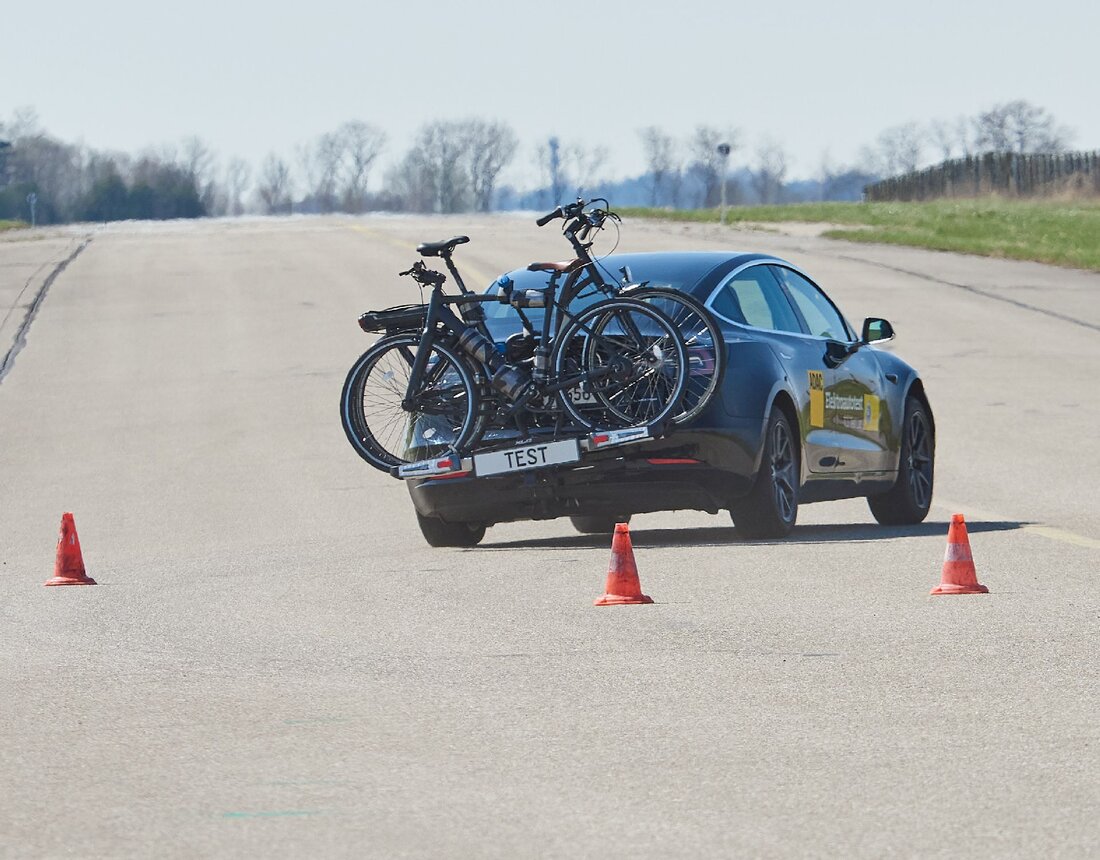Bike rack in the test
The ÖAMTC tested a total of 13 e-bike-compatible and foldable rear bicycle racks in terms of quality, handling and safety.

Bike rack in the test
There are basically three mounting options for bike racks: roof, rear or trailer hitch. "The safest and most stable variant are systems for the trailer coupling. We have therefore currently examined 13 bicycle racks in this category in terms of quality, handling and safety," explains ÖAMTC technician Steffan Kerbl. The pleasing result: All models survived evasive maneuvers at 90 km/h in the test without any problems. “This shows progress compared to tests from the past,” because in addition to one “very good” and ten “good,” there were only two “satisfactory” in the test, and fortunately no product failed,” says Kerbl.
Quality & handling
The test winner is the Uebler i21, which stands out with its easy-to-use installation method, is also the lightest rear carrier and requires the least space when stowed away. At the other end of the test field is the Menabo Antares 2, which overall still scores 'satisfactory'. The complex initial setup and the more cumbersome operation prevent a better rating. The Fischer ProLineEvo also performs only 'satisfactorily' - here too, the initial setup is time-consuming. During the actual assembly, a clamping force of 45 kg must be applied. Between these two models and the test winner there is a wide range of ten products that were rated 'good'. There are also differences in weight. The range extends from 13.2 kg for the Uebler to 21.1 kg for the Atera. In addition to handling, the weight of the carrier, together with that of the bicycles to be transported, is relevant for the maximum permissible support load of the vehicle. All models in the test are foldable, which saves space. However, the required storage volume differs significantly. While the Uebler requires a cuboid volume of only 93 liters, the Atera needs more than twice as much space at 245 liters.
Price and value
The prices of the tested products start at around 300 euros, good rear racks are available from around 400 euros. Some models require a lot of work to set up before they can be used for the first time, while others come fully assembled. In general, the test showed that the more quality and comfort you want, the more you have to spend for it. The test winner comes to over 700 euros. As a minimum requirement, all rear racks in the test had to be able to transport two e-bikes, each weighing 30 kg. “But this is not always the case and must be taken into account when purchasing,” says Kerbl. Not insignificant for handling: When assembled, the selected models can also be folded away from the car using a lever so that the tailgate can be opened normally. The biggest differences in the test were when installing the carriers on the trailer hitch. Assembling the Menabo was the most difficult because the tensioning lever had to be tensioned backwards rather than sideways. With the Fischer product, the force for attaching it to the trailer hitch must be adjusted using an Allen key. The two mostly identical products from Oris and MFT take some getting used to putting on the trailer hitch, but they have a very sophisticated tightening mechanism to apply the necessary 47 kg. Uebler also has its own very good system.
The tips of the yellow angels
Please note the different mounts for the bicycles depending on the rear rack - straps, clamps or screw fasteners. Kerbl advises: "Not every type of fastening is suitable for every bicycle; carbon frames, for example, react sensitively to pressure. There are now many different bicycle models, frame and wheel sizes - we recommend visiting a specialist retailer to try out the different carriers." Before you buy, you should also do the math: The maximum permissible vertical load is stated on the registration certificate or on the nameplate of the trailer hitch. The weight of the bicycles to be transported, together with the weight of the rear rack, must not exceed this permitted support load. When buying, you should also clarify whether the brackets and rail width fit your own (e-)bikes. Loose parts and batteries should be removed before riding, and rain protection or similar covers should be avoided as they act like sails and pull on the bike racks. After driving around ten kilometers, all fastenings should be checked and tightened if necessary. In Austria it is permitted to attach a red license plate with the license plate of the towing vehicle to the bicycle rack. However, when traveling abroad, it is advisable to mount the rear license plate on the rear bicycle rack, otherwise complaints may arise.

 Suche
Suche
 Mein Konto
Mein Konto